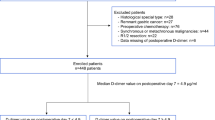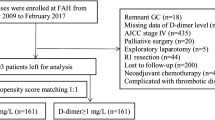Abstract
Purpose
To explore the clinical significance of plasma d-dimer increase for transcatheter arterial chemoembolization (TACE) in patients with primary liver cancer (PLC).
Methods
The clinical data of 80 PLC patients who underwent TACE in our hospital from January 2015 to January 2017 were collected, including the plasma d-dimer level 1 week before TACE (D0), d-dimer level 1 month after TACE (D1) and d-dimer level when the disease begins to progress (D2). 1 Month after TACE, these patients were divided into two groups according to the mRecist criteria: disease-controlled group (CR + PR + SD) and disease-progressing group (PD). In all subjects, progression-free survival (PFS) was recorded. D0 and D1 were compared between the two groups by the rank sum test; and the relation between d-dimer level and PFS was assessed by the Kaplan–Meier test and Breslow test.
Results
In the disease-controlled group, there was no significant difference between D0 and D1 (P > 0.05); in the disease-progressing group, D1 was significantly higher than D0 (P < 0.05) and the D1 is higher than that in disease-controlled group. In the patients with a negative D1 or D2, PFS was longer than those with a positive level (both P < 0.05), but such difference was not statistically significant in D0 (P > 0.05). In the patients with a d-dimer level increase after TACE (group 3), PFS was shorter than that in those with a d-dimer level decrease after TACE (Group 1) and that in those with a relatively stable d-dimer level before and after TACE (Group 2) (P < 0.05); survival in Group 1 was slightly but not significantly longer than that in Group 2 (P > 0.05).
Conclusion
The change in plasma d-dimer level can be used as a biological index to assess the efficacy of TACE and prognosis for PLC patients, and thus, a positive d-dimer level or d-dimer increase after TACE is an unfavorable factor.




Similar content being viewed by others
References
Lafaro KJ, Demirjian AN, Pawlik TM (2015) Epidemiology of hepatocellular carcinoma. Surg Oncol Clin N Am 24(1):1–17
Liu Z, Guo H, Gao F et al (2017) Fibrinogen and d-dimer levels elevate in advanced hepatocellular carcinoma: high pretreatment fibrinogen levels predict poor outcomes. Hepatol Res 47(11):1108–1117
Kvolik S, Jukic M, Matijevic M et al (2010) An Overview of coagulation disorders in cancer patients. Surg Oncol 19(1):e33–e46
Vincenzi B, Di Maio M, Silletta M et al (2015) Prognostic relevance of objective response according to EASL criteria and mRECIST criteria in primary liver cancer patients treated with loco-regional therapies: a literature-based meta-analysis. PLoS One 10(7):e0133488
van den Berg YW, Osanto S, Reitsma PH et al (2012) The relationship between tissue factor and cancer progression: insights from bench and bedside. Blood 119(4):924–932
Go SI, Lee MJ, Lee WS (2015) d-Dimer can serve as a prognostic and predictive biomarker for metastatic gastric cancer treated by chemotherapy. Medicine (Baltimore) 94(30):e951
Abdel-Razeq H, Albadainah F, Hijjawi S et al (2011) Venous thromboembolism (VTE) in hospitalized cancer patients: prophylaxis failure or failure to prophylax! J Thromb Thrombolysis 31(1):107–112
Lyman GH, Khorana AA (2009) Cancer, clots and consensus: new understanding of an old problem. J Clin Oncol 27(29):4821–4826
Falanga A, Panove-Noeva M, Russo L (2009) Procoagulant mechanism in tumor-cells. Best Pract Res Clin Haematol 22(1):49–60
Zhou YX, Yang ZM, Feng J et al (2013) High plasma d-dimer level is associated with decreased survival in patients with lung cancer: a meta-analysis. Tumour Biol 34(6):3701–3704
Diao D, Wang Z, Cheng Y et al (2014) d-dimer: not just an indicator of venous thrombosis but a predictor of asymptomatic hematogenous metastasis in gastric cancer patients. PLoS One 9(7):e101125
Sakurai M, Satoh T, Matsumoto K et al (2015) High pretreatment plasma d-dimer levels are associated with poor prognosis in patients with ovarian cancer independently of venous thromboembolism and tumor extension. Int J Gynecol Cancer 25(4):593–598
Stender MT, Larsen TB, Sorensen HT et al (2012) Pre-TACE plasma d-dimer predicts 1-year survival in colorectal cancer patients with absence of venous thromboembolism (VTE): a prospective clinical cohort study. J Thromb Haemost 10(10):2027–2031
Diao D, Zhu K, Wang Z et al (2013) Prognostic value of the d-dimer test in esophageal cancer during the perioperative period. J Surg Oncol 108(1):34–41
Mego M, Karaba M, Minarik G et al (2015) Relationship between circulating tumor cells, blood coagulation, and urokinase-plasminogen-activator system in early breast cancer patients. Breast J 21(2):155–160
Ge LP, Li J, Bao QL et al (2015) Prognostic and predictive value of plasma d-dimer in advanced non-small cell lung cancer patients undergoing first-line chemotherapy. Clin Transl Oncol 17(1):57–64
Inanc M, Er O, Karaca H et al (2013) d-dimer is a marker of response to chemotherapy in patients with metastatic colorectal cancer. J BUON 18(2):391–397
Liu P, Wang Y, Tong L et al (2015) Elevated pre-TACE plasma d-dimer level is a useful predictor of chemoresistance and poor disease outcome for serous ovarian cancer patients. Cancer Chemother Pharmacol 76(6):1163–1171
Ay C, Dunkler D, Pirker R et al (2012) High d-dimer levels are associated with poor prognosis in cancer patients. Haematologica 97(8):1158–1164
Diao D, Zhu K, Wang Z et al (2013) Prognostic value of the d-dimer test in oesophageal cancer during the perioperative period. J Surg Oncol 108(1):34–41
Funding
This study was not founded by any grants.
Author information
Authors and Affiliations
Corresponding author
Ethics declarations
Conflict of interest
The authors have no conflict of interest to declare.
Ethical approval
All procedures performed in studies involving human participants were in accordance with the ethical standards of the institutional and/or national research committee and with the 1964 Helsinki declaration and its later amendments or comparable ethical standards.
Additional information
Publisher’s Note
Springer Nature remains neutral with regard to jurisdictional claims in published maps and institutional affiliations.
Rights and permissions
About this article
Cite this article
Chen, X., Chang, Z. & Liu, Z. d-dimer increase: an unfavorable factor for patients with primary liver cancer treated with TACE. Cancer Chemother Pharmacol 83, 797–802 (2019). https://doi.org/10.1007/s00280-019-03778-6
Received:
Accepted:
Published:
Issue Date:
DOI: https://doi.org/10.1007/s00280-019-03778-6




